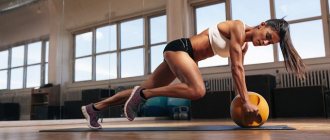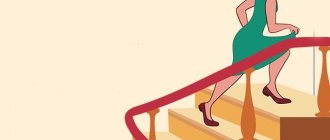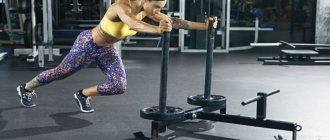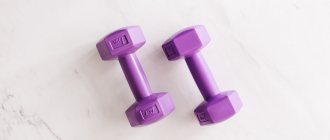© motortion — depositphotos.com
Share:
A sedentary lifestyle has become commonplace. With the development of digital technology and the emergence of a huge number of home-based professions that require only a computer and the Internet, the phrase “sedentary lifestyle” has become applicable to thousands of remote workers. Office positions are no less dangerous in this regard. How does inactivity affect our health? How to avoid the consequences of a sedentary lifestyle if it is impossible to completely abandon it? You will find answers to these and other equally important questions in our article.
What kind of lifestyle is considered sedentary?
Inactivity or physical inactivity is a disruption of the body's activity due to insufficient physical activity or its absence.
The problem of a sedentary lifestyle arose as a result of scientific and technological progress, urbanization, and the spread of means of communication, which simplified our life and replaced active types of recreation (walks, outdoor games).
Determining whether you lead a “active” or sedentary lifestyle is very simple. If you do not move actively during the day for at least half an hour, this is considered inactive. Active movements mean walking, running, and physical exercise.
Cleaning and performing normal household chores do not count as activity. During their execution, the necessary load on the body muscles is not created. When working around the house, we occupy incorrect postures that leave many muscle groups unused.
© macrovector — depositphotos.com
Do exercises
Just 20 minutes of simple exercise in the morning will give you a boost of energy for the whole day. Train yourself to play sports, and this will significantly improve your well-being and help you lead an active lifestyle. A morning jog will be even more effective.
freepik.com
What does a sedentary lifestyle lead to, and why is it dangerous?
The consequences of a sedentary lifestyle are much more dangerous than many people think. This is a deterioration in the quality of life and a reduction in its duration.
If you spend 8 hours sitting at work every day and prefer to drive home instead of walking, you risk living 15-17 years less than those who sit less than 3 hours a day and try to move actively.
What are the dangers of a sedentary lifestyle? Judge for yourself!
- The heart muscle is the first to suffer from immobility. The lack of active physical movements and cardiovascular exercise causes the heart to make less productive contractions, which significantly reduces the tone of the vascular walls.
- Spine. While sitting, we load it almost twice as much as when we stand or walk.
- Poor blood circulation in the brain provokes dizziness, tinnitus, fatigue, and decreased productivity.
- Without activity, muscles lose tone. This leads to rapid physical fatigue, apathy, and a feeling of constant fatigue.
- Low mobility leads to metabolic disorders. Blood moves more slowly through the body and does not sufficiently saturate the cells with oxygen and nutrients.
- Sitting in one place for a long time provokes stagnation of blood and lymph in the pelvis, negatively affecting the functioning of the intestines and genitourinary system.
Healthy lifestyle
The problems of modern society lead to a significant deterioration in a person’s physical and emotional state. This is why it is so important to lead a healthy lifestyle. A healthy lifestyle includes several interrelated elements:
- Rejection of bad habits. Such habits include alcohol abuse, smoking, and drug use.
- Proper distribution of rest and physical activity.
- Healthy sleep. It should be complete and regular and allow both body and mind to rest.
- Control of emotional state. It is important to try to avoid stress and try to saturate your life with positive emotions.
- Proper nutrition. Eating healthy foods strengthens the immune system, helps control weight, and improves physical well-being.
- Personal hygiene. “Cleanliness is the key to health,” the proverb says quite rightly.
- Social aspect. It represents human behavior in society, the acquisition of communication skills.
Compliance with the above principles is aimed at improving health and can increase a person’s life span.
How does a sedentary lifestyle affect the body from the inside?
Sitting every day in the office, in public transport, at home at the dining table or on the sofa watching TV has a negative impact not only on posture and muscle tone, but also provokes the development of a wide range of diseases.
Diseases of the musculoskeletal system
Those whose work is closely related to sitting at a computer suffer from lumbar and cervical osteochondrosis. Most often, the localization of cervical osteochondrosis is right-sided, since the right hand works with a computer mouse, writes, and performs other actions.
Also, “adherents” of a sedentary lifestyle often have intercostal neuralgia, lumbago, radiculitis, dizziness and headaches.
Diseases of the cardiovascular system
Slow blood circulation provokes the development of venous insufficiency (varicose veins) and thrombosis. Without proper load, the heart suffers. The heart muscle “gets used” to working at half strength, disrupting the general condition of the circulatory system in the body, which affects all organs. The likelihood of strokes and heart attacks increases. Life expectancy is reduced.
Overweight
Lack of physical activity, non-compliance with the principles of a healthy diet, stress are factors leading to excess weight gain. Sitting in the office, we spend fewer calories than we consume, which causes “beer bellies” to appear, “breeches” in the thighs, and body weight to increase.
According to the forecasts of the weekly medical journal “The Lancet”, by 2025, 20% of our planet’s population will suffer from excess weight, including due to a sedentary lifestyle.
Constipation and hemorrhoids
Impaired intestinal motility, caused by immobility during the day, leads to chronic constipation. Constipation, in turn, becomes the cause of another unpleasant disease - hemorrhoids.
If you have prerequisites for constipation, do not let it become chronic. Warm up, regularly change the position in which you sit, pump up your abs, massage your abdomen, and watch your diet. This will significantly reduce the likelihood of hemorrhoids.
© macrovector — depositphotos.com
Modern society
Fast food, social networks, alcohol, smoking, cars... All these are the realities of modern man. An accelerated pace of life, constant bustle and fatigue have become indispensable attributes of society. Therefore, spending a day off lying on the sofa with the TV remote control seems to be a more pleasant and easier pastime than walking and other forms of active recreation.
In addition, the latest technology and automation make life much easier and reduce the need to be active. Machines do all the hard work today. For a picnic in nature, you no longer need to walk with a backpack on your back. It is enough to get into a comfortable car that will easily take you to the desired point.
Life has become easier, but time has become less. As a consequence of these two factors, today the percentage of the population suffering from obesity is growing exponentially, depression has become the scourge of modern society, and addiction to the Internet and television is officially recognized as a serious psychological disease. A constant lack of time and energy is a logical excuse for those people who have put taking care of their health into the background.
Consequences of a sedentary lifestyle
Sitting at your desk, on the couch, or at the dinner table for long periods of time does no one any good. Doctors share the consequences of a sedentary lifestyle for men and women.
For men
A sedentary lifestyle has a negative impact on the prostate. Poor circulation and stagnation of blood flow and lymph in the pelvic organs leads to prostatitis, which in turn leads to a decrease in potency. Today there are already a large number of infertile couples due to poor sperm motility and prostatitis. In addition to sexual problems, men who lead a sedentary lifestyle are often bothered by hemorrhoids.
For women
The same reason - stagnation in the pelvis - provokes disorders in the sexual sphere in women and becomes the cause of uterine pathologies (polyps, endometriosis), as well as painful menstruation.
A general deterioration in well-being due to a sedentary lifestyle and frequent stress cause hormonal disorders, mastopathy, ovarian cysts, and menstrual irregularities.
This video is very detailed, simple and clear:
Varicose veins
The main risk groups are women (due to hormonal characteristics) and people with a sedentary lifestyle. It is not difficult to guess that the most severe stages of varicose veins occur in those who fall into both categories - that is, in women who move little. By the way, it doesn’t matter whether you sit, lie or stand a lot - if the calf muscles and foot muscles do not work properly, vascular tone drops, and blood stagnation occurs.
What to do? And again movement will come to the rescue - walks in the fresh air, aerobics and especially swimming, which perfectly tones the blood vessels. If varicose veins have already reached a certain stage of development, laser treatment, sclerotherapy and other manipulations are usually prescribed, which the attending physician will tell you in more detail.
How to avoid the consequences of a sedentary lifestyle?
Even if you have a clear idea of the dangers of a sedentary lifestyle, you are unlikely to be able to completely get rid of it. Shouldn’t you give up a promising job in a good office or the clients you’ve accumulated through many years of freelance work? And not everyone has the opportunity to get to work on foot to compensate for the harm of sitting for eight hours.
What to do? Exercise, nutritional adjustments, and little tricks that you can use in your workplace today will help reduce the negative impact of sitting at your workplace.
Physical activity + exercises you can do right at your workplace
Try to change your body position every 15-20 minutes. Get up from your desk more often to stretch, do a couple of side bends, and stretch your legs. This way the blood in the body will circulate normally.
Exercises you can do while sitting at your desk:
- Sit back in your chair and straighten your legs. Bend and straighten your knees 10-15 times each.
- Straighten your leg, pull up your toes and perform circular movements with your ankle 10-15 times on each leg.
- Slowly rotate your head clockwise and counterclockwise 5 times.
- With cervical osteochondrosis, it is advisable not to make rotational movements of the head. Instead, stretch your arms out to the sides and try to reach your left shoulder with your right hand, placing your right hand behind your head. Do this 15-20 times with one and the other hand, and then 15-20 times with both hands at the same time. Pull the top of your head up. Try not to tilt your head forward.
- Do 10 shoulder rolls back and 10 forwards.
- Tighten and relax your buttock muscles 20-25 times.
- While sitting on a chair, alternately raise and lower your right and left arms 10-15 times.
- Place one palm against the other and forcefully press your palms against each other. Keep your palms tense several times for 10-15 seconds.
- Squeeze and unclench your fingers. Stretch with your fingers interlocked.
- Lower your arms along your body, relax them and shake your hands for a few seconds.
- Move your chair back, lean forward and bring your shoulder blades together as much as possible. Repeat several times.
- Sit on the edge of a chair, straighten up and suck in your stomach for a few seconds. Do at least 50 times.
- Alternately lift your toes and heels off the floor.
- Lift your shoulders up as you inhale and sharply “throw” them down as you exhale.
- Move away from the table, straighten your legs and try to reach the toes of your shoes as much as possible with your fingers.
- Take off your shoes and roll a glue stick or other round stationery across the floor.
Try to make such a warm-up a “mandatory program” every day. Don't be afraid to cause confusion among your work colleagues. Remember that preventing a problem is much better than fighting it. Below is a video that will help you have a clearer understanding of gymnastics right “on a chair”:
Don't forget about morning exercises. Let her become your faithful companion every morning. Table with exercises for morning exercises:
| Exercise | Number of repetitions or duration |
| Walking in place with knees raised high (70-80 times). | 1 minute |
| Starting position – hands in front of the chest. With sharp movements, bring your shoulder blades together, moving your elbows back. | 8-12 times |
| I.P. – feet shoulder-width apart, hands on the belt. Circular movements of the pelvis. | 8-12 times |
| I.P. - hands on the belt. Squats. | 10-20 times |
| Press lying on your back. | 10-20 times |
| I.P. – feet shoulder-width apart, hands on the belt. Side bends. | 8-12 times |
| Walk slowly with deep breathing. | 1-2 minutes |
Download the list of exercises here so you don’t lose it.
© macrovector — depositphotos.com. Pyramid of gradual increase in physical activity
Nutrition
In order not to gain excess weight, to always be full of strength and energy, it is important not only to maintain physical activity, but also to monitor nutrition. Going on a strict diet is not an option: since the body already suffers from a lack of activity and a slow metabolism, strict dietary restrictions will not benefit it.
Four simple rules of nutrition for a sedentary lifestyle:
- Follow a meal schedule. Eating at the same time disciplines, helps plan work time taking into account the lunch break, and promotes maximum absorption of nutrients and vitamins from food. All meals, even snacks, should be fixed in time.
- Eat smaller portions. Get up from the table feeling like you haven't eaten enough. A slight feeling that you are hungry is good for the body. Dull it with a healthy snack: a banana, nuts, an apple, a mug of tea. The total number of meals per day should be at least 5.
- If you work in an office, don't forget to have breakfast at home. Breakfast is an important meal for the body. By skipping it, you disrupt your entire diet.
- Eliminate fast food from your diet. Pizza, burgers, buns, cakes and other sweets are contraindicated for a sedentary lifestyle. They contain too many calories that you simply cannot burn while typing on your keyboard throughout the day.
© BVDC01 — depositphotos.com
Other tips
If it is impossible to escape from a sedentary lifestyle, make sure that it causes as little harm as possible. Since you spend most of your time sitting at your desk, consider ways to stay physically active while at work.
Three tips for setting up your workplace:
- Remove unnecessary objects that may prevent you from stretching your legs under your desk and stretching them during the day.
- If possible, have snacks, tea and lunch not at your workplace, but in a special designated area of the office or in the kitchen. To do this, you will at least get up from your chair and walk around, plus you can stand by the window while you drink tea.
- Try to get out of your chair more often. Even if you have the necessary documents and objects at arm's length, do not drive up to them in a chair and do not ask your colleagues to hand them over, but stand up and take them yourself.
Constipation
Against the background of physical inactivity, constipation can become painfully chronic. The problem begins quite unnoticed: the intestines become “lazy” from time to time, trips to the toilet become irregular, and stool retention occurs for 2-3 days. Added to this is bloating, a feeling of heaviness, discomfort and even pain. Toxins accumulate in the intestines, which damage the cells of the mucous membrane, and ultimately literally all systems of our body begin to suffer. In addition, constipation and dysbacteriosis go hand in hand, one provokes the other, as a result, both well-being and skin condition worsen, allergic reactions appear, and immunity decreases.
What to do? Don't forget about physical activity - it has a positive effect on intestinal motility. Even if these are walks, even at a leisurely pace, the benefits for the body will still be significant. Review your diet: include more fermented milk products in your menu, eat more vegetables and fruits - they contain a lot of fiber, which is simply necessary for healthy intestinal function. Fiber activates intestinal motility, removes waste and toxins, normalizes stool and promotes regular cleansing of the body, besides, it itself is food for beneficial bacteria in the intestines and thereby improves intestinal microflora.
Of course, in winter it is more difficult to eat a lot of fresh vegetables and fruits; we are accustomed to refined foods, boiled, baked, fried, so our intestines often begin to get lazy. Fiber in its purest form will help solve the problem of constipation! Look for it in special biocomplexes, for example, in the English laxative “Fitomucil Norm”. This is a completely natural and safe constipation remedy that does not contain senna, artificial additives, preservatives or sugar. "Fitomucil Norm" consists of soluble and insoluble fiber of a special type of plantain psyllium and domestic plum pulp. Both components ensure healthy digestion, restore regular bowel movements, and promote a gentle and comfortable bowel movement without the urge to pee or painful cramps (as with other more aggressive laxatives).
Psyllium is a leader in the content of the most beneficial soluble fiber, which soothes irritated intestines, normalizes stool, and promotes its comfortable evacuation to the outside. Thanks to the action of the drug, comfort and lightness in the stomach returns, the intestines begin to work like clockwork!
The drug is not addictive or allergic, it can be used by pregnant and lactating women, it is especially useful for older people.
The contents of the Fitomucil sachet can be dissolved in juice, yogurt or water and drunk before meals, or you can take it as part of soups, salads or desserts. Don't forget that soluble fiber absorbs a lot of water, so be sure to drink more fluids while taking Phytomucil.
Physical inactivity is truly a real scourge of our time. But you can fight it and it’s not that difficult. For example, right now, after reading the article, you can get up and go for a walk. We guarantee that your body will sincerely thank you!
https://www.fitomucil.ru/
Instagram @fitomucil.ru
Marathon running while standing
You can always find an opportunity to stand up for at least a minute. If you work at a computer, standing for at least an hour during the workday can burn 60 calories, further reducing the health risks associated with a sedentary lifestyle. Don't you think this result is too impressive? Over the course of a five-day working week, this amount increases to 300 kcal, over the course of a year to 10 thousand kcal, and this is the same amount as consumed during three marathon races.
Table: Book “Swedish Health Rules”
Physical culture of the body
Physical culture of the body is a broader concept than sports tourism, sports or hardening. It is part of human culture, which has its own values, knowledge and traditions. These are activities aimed at developing and improving the physical characteristics of the human body. Physical education classes include several components:
- Morning exercises. Many people habitually call it “charging”. It really aims to charge the body with energy after a night's rest. During sleep, muscles relax, and morning exercises help tone them.
- Doing physical exercise and playing sports. These activities are aimed at developing physical abilities. Leading a passive lifestyle, a person does not use even a small part of the potential given to him by nature.
- Physical activity. The manifestation of physical activity affects the functioning of the entire body and is the prevention of many diseases.
Elements of physical culture of the body can also include personal hygiene and hardening. This strengthens the body, making it more resistant to various diseases.
What to do
It’s difficult to come up with something new or surprising here - everything has been said a long time ago, and we are sure that you know it:
- Try working while standing . We will definitely study this issue in detail from personal experience and write you an article, so, as they say, stay with us!











